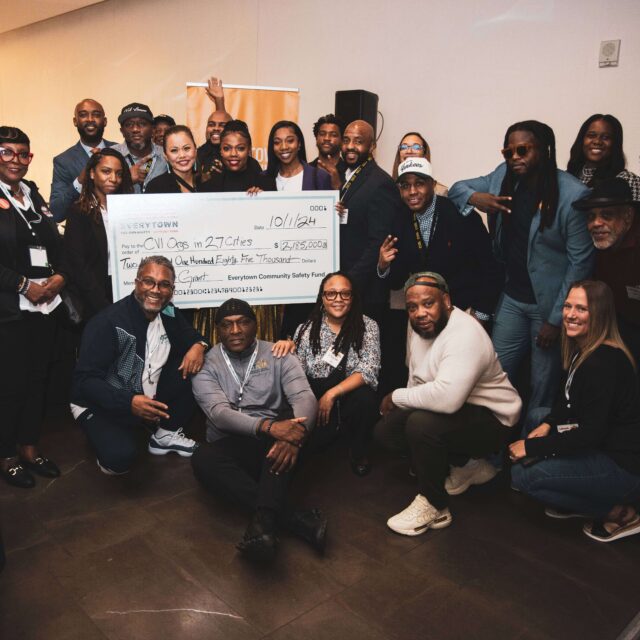12 Community Safety Fund Grantees Using the Hospital-Based Violence Intervention Program Model to Make a Difference In Their Communities

4.30.2025
Since 2020, the Everytown Community Safety Fund (CSF) is proud to have directly invested grants and capacity-building training to 12 organizations running hospital-based violence intervention (HVIP) programs. HVIPs are a critical part of the community-based violence intervention (CVI) ecosystem.
What is community-based violence intervention?
CVI organizations and/or programs build personal relationships with and directly serve the people in their neighborhoods or communities. These organizations work to address the root causes of violence, including historic disinvestment in neighborhoods, food and/or housing insecurity, and discriminatory policing. CVI organizations strive to reduce barriers to accessing services while reaching those who are at the highest risk of violence.
Despite the vital role that CVI organizations, including HVIPs, play in reducing violence and rebuilding community trust, the organizations themselves have historically faced barriers to accessing funding. Additionally, in just the last few weeks, several important sources of federal funding for key public safety initiatives, including CVI programs, have been cut. In the wake of barriers and uncertainties, CSF grantees remain committed to doing everything in their power to serve those most at risk in their communities.
“HVIPs are programs dedicated to assisting clients with changing their life course, not solving macro-level issues,” said Nazsa S. Baker, PhD, MA, the Research Director and Program Manager at The Wraparound Project. “Regardless of the current political and funding landscape, HVIPs will continue to operate at a capacity where programs are contributing to disrupting cycles of community violence and providing resources for individuals’ social drivers of health.”
What are hospital-based violence intervention programs (HVIPs)?
Caught in the Crossfire, an HVIP run by CSF grantee Youth Alive, pioneered the HVIP model in the early 1990s. Sherman Spears, a survivor of violence, invented the model to “address both the urgent need for violence intervention and the ongoing service needs of survivors, helping them get back to life.”
Today, HVIPs across the country interrupt violence in a hospital setting, serving direct survivors of violence along with their families. These programs are either hospital-based—led by a CVI organization and run out of a hospital—or hospital-linked—led by a hospital, which connects patients to CVI services. No matter the model, program services start at a patient’s bedside. In the days, weeks, and months following a violent injury, HVIP client advocates continue to provide support to the survivor of violence and their loved ones.
HVIPs use crisis intervention, including counseling and service referrals, to prevent reinjury or retaliation. For example, the Turning the Tide Violence Intervention Program (TTVIP) at MUSC Health connects with patients while they are hospitalized, working to provide anti-retaliation counseling, prepare a safety plan for discharge, and build rapport with the patient. On average, TTVIP provides intervention services for patients for 6-12 months after a patient has been discharged. TTVIP client advocates, like those in many other HVIP programs, also refer patients to local services and resources for:
- Education,
- Substance use,
- Employment,
- Mental health care,
- Housing, and more.
The services under the “and more” umbrella vary widely and are always tailored to community-specific needs. For example, CSF grantee Hand-in-Hand also assists patients with navigating “the criminal justice process” and “coordinating follow-up medical appointments,” while grantee Aim4Peace “intervene[s] in conflicts” directly if needed to try “to prevent further violence.”
HVIP programs often focus on supporting patients of specific ages. Some, like the At-Risk Intervention Mentoring (AIM) HVIP run by CSF grantee GRASP, work specifically with youth to “provide one-on-one focused mentoring” over the course of several months, working to build “long-term plans to change at-risk behaviors.” Others, like the CSF grantee the Next Step Program, support survivors across a range of ages to connect them with critical services in both clinical and community settings.
Why are HVIPs important?
The violent injury of one person can have a ripple effect, causing trauma for that individual’s loved ones and their broader community. HVIPs can help to interrupt the cycle of violence, promoting better health and well-being outcomes for individuals and communities. According to a joint report released by Everytown for Gun Safety Support Fund and The Health Alliance for Violence Intervention (HAVI), “Promising research shows that HVIPs are associated with reduced risks of future violence and crime.” The report cited studies in multiple cities that “found that HVIP participants’ reinjury rates were at least 50 percent lower than nonparticipants’—over periods ranging from two months to six years after they had completed the program.1Catherine Juillard et al., “A Decade of Hospital-Based Violence Intervention: Benefits and Shortcomings,” Journal of Trauma and Acute Care Surgery 81, no. 6 (December 2016): 1156–61, https://doi.org/10.1097/TA.0000000000001261; Noé Romo et al., “Improving Adolescent Violent Trauma Outcomes with a Hospital-Based Violence Prevention Initiative,” Hospital Pediatrics 13, no. 2 (January 2023): 153–58, https://doi.org/10.1542/hpeds.2021-006428; Carnell Cooper, Dawn M. Eslinger, and Paul D. Stolley, “Hospital-Based Violence Intervention Programs Work,” Journal of Trauma: Injury, Infection, and Critical Care 61, no. 3 (September 2006): 534–37, https://doi.org/10.1097/01.ta.0000236576.81860.8c; Gerardo Gomez et al., “Project Prescription for Hope (RxH): Trauma Surgeons and Community Aligned to Reduce Injury Recidivism Caused by Violence,” American Surgeon 78, no. 9 (September 2012): https://doi.org/10.1177/000313481207800942.”
On its website, CSF HVIP grantee Project Ujima highlights that both the youth and adults who voluntarily participate in their program “are less likely to be re-victimized.” Project Ujima states that participants also experience “better medical outcomes after injury” and “improved school, youth, and family relationships.”
Some programs, like CSF grantee the Paterson Healing Collective, also offer violence prevention and education services outside of a clinical setting. These proactive violence prevention efforts strive “to raise awareness about the root causes of violence, conflict resolution skills, anger management, and healthy relationship building” to prevent future violence.
Do HVIPs work?
According to the report by Everytown and The HAVI, while research is still emerging, several studies of HVIPs in cities across the country show promising results in multiple areas, including:
- Reduced reinjury rates2Catherine Juillard et al., “A Decade of Hospital-Based Violence Intervention: Benefits and Shortcomings,” Journal of Trauma and Acute Care Surgery 81, no. 6 (December 2016): 1156–61, https://doi.org/10.1097/TA.0000000000001261; Noé Romo et al., “Improving Adolescent Violent Trauma Outcomes with a Hospital-Based Violence Prevention Initiative,” Hospital Pediatrics 13, no. 2 (January 2023): 153–58, https://doi.org/10.1542/hpeds.2021-006428; Carnell Cooper, Dawn M. Eslinger, and Paul D. Stolley, “Hospital-Based Violence Intervention Programs Work,” Journal of Trauma: Injury, Infection, and Critical Care 61, no. 3 (September 2006): 534–37, https://doi.org/10.1097/01.ta.0000236576.81860.8c; Gerardo Gomez et al., “Project Prescription for Hope (RxH): Trauma Surgeons and Community Aligned to Reduce Injury Recidivism Caused by Violence,” American Surgeon 78, no. 9 (September 2012): https://doi.org/10.1177/000313481207800942.
- Reductions in subsequent misdemeanors and violent crimes3Cooper, Eslinger, and Stolley, “Hospital-Based Violence Intervention Programs Work;” Marla G. Becker et al., “Caught in the Crossfire: The Effects of a Peer-Based Intervention Program for Violently Injured Youth,” Journal of Adolescent Health 34, no. 3 (March 2004): 177–83, https://doi.org/10.1016/j.jadohealth.2003.04.001; Tina L. Cheng et al., “Effectiveness of a Mentor-Implemented, Violence Prevention Intervention for Assault-Injured Youth Presenting to the Emergency Department: Results of a Randomized Trial,” Pediatrics 122, no. 5 (November 2008): 938–46, http://dx.doi.org/10.1542/peds.2007-2096.
- Improved mental health4Elizabeth Gorman et al., “Beyond Recidivism: Hospital-Based Violence Intervention and Early Health and Social Outcomes,” Journal of the American College of Surgeons 235, no. 6 (December 2022): 927–39, https://doi.org/10.1097/XCS.0000000000000409; Michael N. Levas, Emmalee A. Boyle, Marlene Melzer-Lange, and Julie Panepinto, “Improvement in Quality of Life among Violently Injured Youth after a Brief Intervention,” Journal of Trauma and Acute Care Surgery 81, no. 4 (October 2016): S61–S66, https://doi.org/10.1097/TA.0000000000001061.
- Greater attendance at medical appointments,5Romo et al., “Improving Adolescent Violent Trauma Outcomes.” and
- Greater use of local services6Michel B. Aboutanos et al., “Brief Violence Interventions with Community Case Management Services Are Effective for High-Risk Trauma Patients,” Journal of Trauma and Acute Care Surgery 71, no. 1 (July 2011): 228–37, https://doi.org/10.1097/TA.0b013e31821e0c86.
However, for many grantees, the individual stories of how HVIP participants’ lives have been positively changed are just as meaningful metrics of success. HVIPs at Grady Health Foundation’s IVYY and Regional One Health’s Rx for Change were featured in newsclips highlighting how individuals in the community have benefited from the violence intervention provided through these programs.
You can visit each of the links below to learn more about how these CSF grantees are changing lives in their communities.





